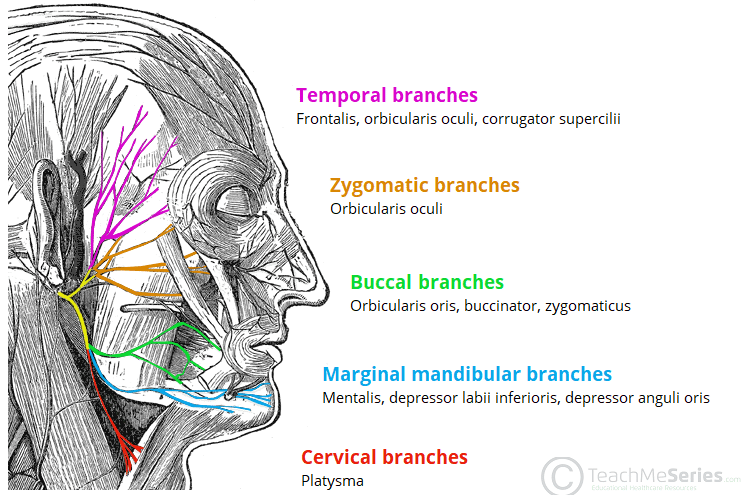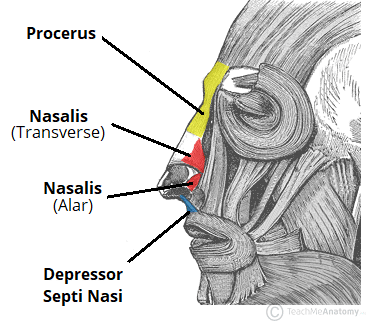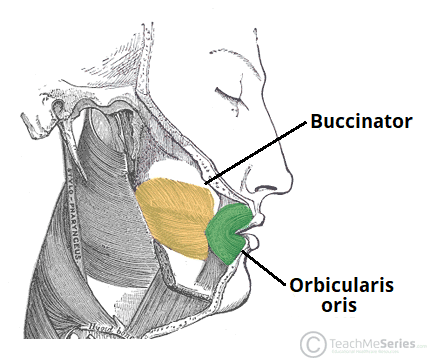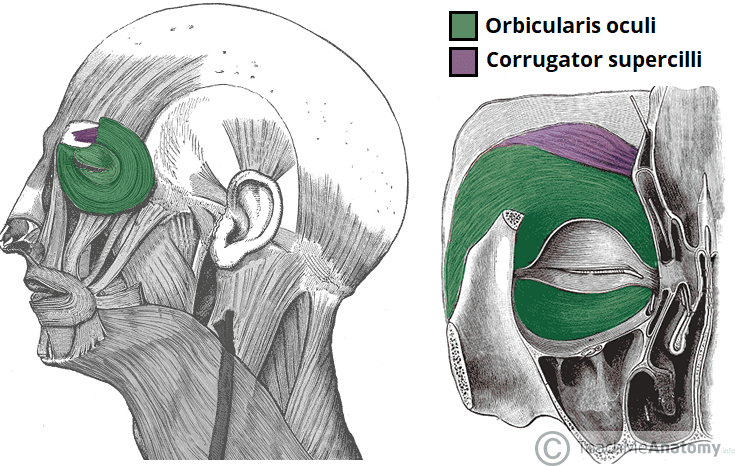The muscles of facial expression are located within the subcutaneous tissue of the face. They originate from bone or fascia and insert onto the skin. As they contract, the muscles pull on the skin to exert their effects.
These muscles all develop from the second pharyngeal arch. As they migrate from the arch, they take their nerve supply with them. As such, they are all innervated by branches of the facial nerve.
The facial muscles can broadly be categorised into three groups – orbital, nasal and oral.
In this article, we shall look at the anatomy of the muscles of facial expression – their attachments, actions and clinical relevance.

Fig 1
Innervation to the muscles of facial expression via the facial nerve (CN VII)
Premium Feature
3D Model
Orbital Group
The orbital group of facial muscles contains two muscles associated with the eye socket. These muscles control the movements of the eyelids, important in protecting the cornea from damage. They are both innervated by the facial nerve.
Orbicularis Oculi
The orbicularis oculi muscle surrounds the eye socket and extends into the eyelid. It has three distinct parts – palpebral, lacrimal, and orbital.
- Attachments – Originates from the medial orbital margin, the medial palpebral ligament, and the lacrimal bone. It inserts onto the skin around the margin of the orbit as well as the tarsal plates of the eyelid.
- Actions:
- Palpebral part – gently closes the eyelids.
- Lacrimal part – involved in the drainage of tears.
- Orbital part – tightly closes the eyelids.
- Innervation – Temporal and zygomatic branches of the facial nerve
Corrugator Supercilii
The corrugator supercilii is a much smaller muscle and is located posteriorly to the orbicularis oculi.
- Attachments – Originates from the medial aspect of the superciliary arch and inserts onto the skin of the eyebrow.
- Actions – Draws the eyebrows together, creating vertical wrinkles on the bridge of the nose (associated with frowning).
- Innervation – Temporal branches of the facial nerve.
Clinical Relevance
Paralysis to the Orbital Muscles
If the facial nerve becomes damaged, the orbital muscles will cease to function. As they are the only muscles that can close the eyelids, this has some serious clinical consequences.
- The eye cannot shut – this can cause the cornea to dry out. This is known as exposure keratitis.
- The lower eyelid droops, called ectropion. Lacrimal fluid pools in the lower eyelid and cannot be spread across the surface of the eye. This can result in a failure to remove debris, and ulceration of the corneal surface.
The test for facial nerve palsy involves raising the eyebrows and closing the eyelids.
Premium Feature
Dissection Images


Nasal Group
The nasal group of facial muscles are associated with movements of the nose and the skin surrounding it.
Nasalis
The nasalis is the largest of the nasal muscles and is comprised of two parts: transverse and alar.
- Attachments:
- Transverse part – originates from the maxilla, immediately lateral to the nose. It attaches onto an aponeurosis across the dorsum of the nose.
- Alar part – originates from the maxilla overlying the lateral incisor. It attaches to the alar cartilage of the nasal skeleton.
- Actions:
- Transverse part – compresses the nasal opening.
- Alar part – widens the nasal opening.
- Innervation – Buccal branches of the facial nerve.
Procerus
The procerus is the most superior of the nasal muscles. It lies superficially to the other muscles of facial expression.
- Attachments – Originates from the nasal bone and inserts onto the skin of the lower medial forehead.
- Actions – Pulls the eyebrows downward to produce transverse wrinkles over the nose (associated with frowning)
- Innervation – Buccal branches of the facial nerve
Depressor Septi Nasi
The depressor septi nasi muscle assists the alar part of the nasalis in opening the nostrils.
- Attachments – Originates from the maxilla (above the medial incisor tooth) and inserts onto the nasal septum.
- Actions – Pulls the nasal septum inferiorly to widen the nasal opening.
- Innervation – Buccal branches of the facial nerve.

Fig 3
The nasal muscles of facial expression. Note the nasalis muscle is comprised of two parts.
Oral Group
The oral muscles of facial expression are responsible for the movements of the mouth and lips. They are required in singing and whistling and add emphasis to vocal communication.
The group consists of the orbicularis oris, buccinator, and various smaller muscles.
Orbicularis Oris
The orbicularis oris is the main sphincter muscle of the lips.
- Attachments – Arises from the maxilla and from the other muscles of the cheek. It inserts onto the skin and mucous membrane of the lips.
- Action – Closes the lips to narrow the oral opening.
- Innervation – Buccal branches of the facial nerve.
Buccinator
The buccinator is a thin, square-shaped muscle. It is located between the mandible and maxilla, deep to the other muscles of the face.
- Attachments – Originates from the maxilla and mandible. The fibres run in an inferomedial direction, blending with the orbicularis oris muscle and the skin of the lips.
- Actions – Pulls the cheek inwards against the teeth, preventing accumulation of food in that area.
- Innervation – Buccal branches of the facial nerve.
Minor Oral Muscles
There are other minor muscles that act on the lips and mouth. They can be divided into upper and lower groups:
- The lower group contains the depressor anguli oris, depressor labii inferioris and the mentalis.
- The upper group contains the risorius, zygomaticus major, zygomaticus minor, levator labii superioris, levator labii superioris alaeque nasi and levator anguli oris.

Fig 4
The main oral muscles of facial expression. Note how the fibres of buccinator and orbicularis oris blend together
Clinical Relevance
Paralysis to the Oral Muscles
If the facial nerve is dysfunctional, the oral muscles can become paralysed. The patient may present with difficulty eating, with food collecting between the teeth and cheeks. In addition, the tissue around the mouth and cheeks sags, and is drawn across to the opposite side while smiling.
